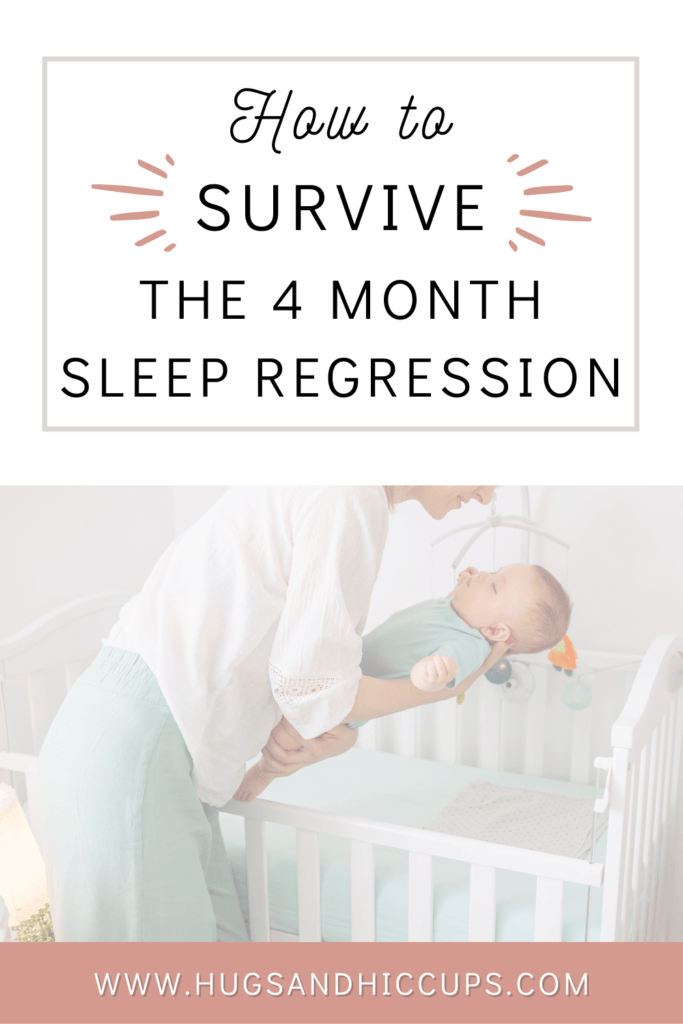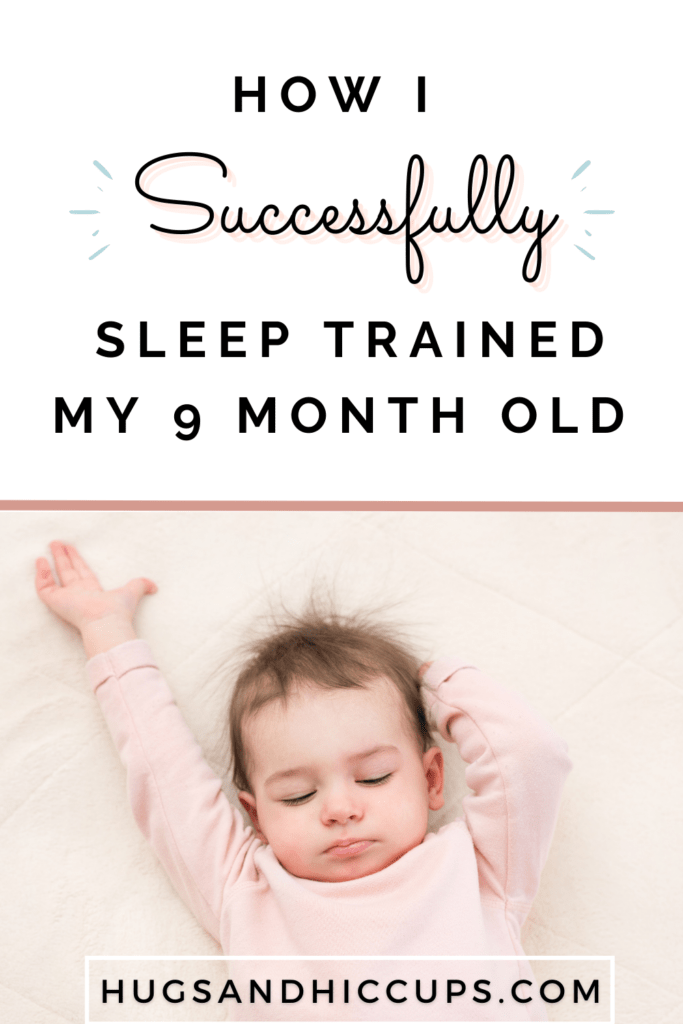Around 6 months old, a baby’s sleep pattern develops into a mature sleep cycle. The reason why the 4-month sleep regression is so difficult is because it’s the first major regression, but may also mark significant milestones in your baby’s development. The 4-month sleep regression can start as early as 12 weeks old and may last anywhere from 2 to 5 weeks, however, understanding your newborn’s sleep patterns may alleviate some frustrations and concerns.
When my daughter was 3 months old, I began to overuse the dreaded word “regression” to explain to everyone why she wasn’t sleeping through the night. She also refused naps or would only sleep for a half hour or less. I have no idea how she functioned because she was still generally happy during the day.
The 4-month sleep regression was TERRIBLE, but it also meant our daughter’s sleep cycle was beginning the process of developing into a mature sleep cycle, which also meant she would be on her way to sleeping through the night for longer stretches and taking longer naps.
The 4-month sleep regression is a developmental progression, not a regression.
Are Sleep Regressions Real?
Yes and no.
The New York Times did an article addressing this question back in 2019 and interviewed psychologists as well as pediatricians. Did frequent night wakings, fussiness, and refusal to nap coincide with developmental changes? There hasn’t been a substantial amount of research done and according to this article, “Neurologists are just beginning to understand brain patterns during the first two years of life.”
In fact, the term ‘regression’ blew up after only one study was published in 1992, which was conducted by two psychologists with only 15 participants (mothers filling out a questionnaire regarding their baby’s behavior every half hour.)
I could barely remember to write down one sentence about my child’s growth once a day in my Mom’s One Line-a-Day Journal, so I can imagine there must have been a lot of room for human error.
However, even without substantial evidence, there are a ton of mom forums, parenting blogs, and even friends and family members with kids whose babies’ sleep problems happen at around the same time.
Dr. Plooij and Dr. van de Rijt published “The Wonder Weeks” the same year they published their study, categorizing a baby’s developmental changes into 10 leaps.

While an interesting read, and also just pretty cool to see how your baby is developing (which remember, still needs further research, not just a questionnaire filled out by exhausted mothers), I can’t say if my baby went through the leaps, but 12-17 weeks was an absolute nightmare for us. That would be around the 3rd and 4th Leap, which is considered the 4-month sleep regression.
Call them leaps or sleep regressions.
The bottom line is, something is going on that has parents everywhere seeking out help to overcome it.

So are sleep regressions real? You’re here because you’re dealing with a fussy, clingy, cranky baby around the 4-month mark. Does it coincide with a baby’s development? Maybe and maybe not.
Your baby is constantly growing and learning new skills, especially within the first year of life. Although there isn’t a sufficient amount of evidence linking sleep to your baby’s development, I think it’s safe to say from a parent’s perspective that it doesn’t matter.
What matters is the understanding that sleep disruptions in the first year of your baby’s life are NORMAL.
My daughter only slept through the night for one consecutive week during the first 12 months, and that happened only after we sleep-trained when she was 9 months old (then she got sick). At a year old she was sleeping at least 12 hours through the night.

Our daughter had a difficult time through all the common sleep regressions, which are generally around 4, 8, 12, and 18 months old. She is my inspiration for this blog because nothing was easy with her. As a new parent, I thought I was doing everything wrong.
Always remember, your learning as your baby is developing. Even if you’re not a new parent, every baby is different. Your first could have slept great and now your second child is a night owl. Give yourself some grace!
Why do Babies have the 4-Month Sleep Regression?
The results from a study in the Development of Salivary Cortisol Circadian Rhythm and Reference Intervals in Full-Term Infants found that the “Cortisol circadian rhythm in infants can already be detected—on a group level—at one month of age, which is earlier than previous studies have shown.”
What is cortisol? Cortisol is the main stress hormone and plays a vital role in how your body operates, including sleep/wake cycles.
Adults should have higher cortisol levels in the morning to help their bodies wake up, and lower cortisol levels in the evening to help their bodies fall asleep. According to the above study, morning and evening cortisol levels showed a significant difference at around 3 months of age.
I believe a lot of infant sleep problems have to do with the hormone cortisol and the development of a baby’s circadian rhythm.
Our daughter started the 4-month sleep regression at 3 months old and it lasted about 5 weeks (It was an absolute nightmare). However, it’s not necessarily a ‘sleep regression’ but a developmental progression. Understanding why sleep regressions happen will hopefully help you navigate your baby’s changing sleep cycle.
Your baby is transitioning from newborn sleep cycles into a light-related circadian rhythm close resembling that of an adult. Instead of spending half of their sleep in REM and half of their sleep in NREM, your baby will progress into REM sleep later on in their sleep cycle.
Different sleep sites say at 4 months old, your baby’s sleep cycle can last 30-50 minutes, 40-50 minutes, or 60-120 minutes. Evidence-based research says it lasts about 50 minutes 1Patel AK, Reddy V, Shumway KR, et al. Physiology, Sleep Stages. [Updated 2022 Sep 7]. In: StatPearls [Internet]. Treasure Island (FL): StatPearls Publishing; 2023 Jan-. Available from: https://www.ncbi.nlm.nih.gov/books/NBK526132/ . Adults cycle through light and deep sleep about every 90 minutes. By 6 months old, your baby’s circadian rhythm will have developed into a similar sleep pattern to an adult’s 2El Shakankiry HM. Sleep physiology and sleep disorders in childhood. Nat Sci Sleep. 2011 Sep 6;3:101-14. doi: 10.2147/NSS.S22839. PMID: 23616721; PMCID: PMC3630965. At six months of age, the longest continuous sleep episode may lengthen to six hours 3Patel AK, Reddy V, Shumway KR, et al. Physiology, Sleep Stages.
Let me repeat that. At 6 months old, the longest stretch of sleeping through the night is about 6 hours. This is the norm, not 8 hours or 10 hours. 6 HOUR STRETCHES.
So there is NREM sleep and REM sleep and by the time your baby is 6 months old, their sleep cycle will have developed into 4 distinct stages similar to that of an adults 4El Shakankiry HM. Sleep physiology and sleep disorders in childhood. However, before 6 months old, sleep cannot be divided into the 4 stages of a mature sleep pattern.
- Non-REM or NREM has 4-stages with deep sleep occurring in the first one third of the night.
- Stage 1 – Your baby is getting very, very sleepy. If they’re dozing off in your arms, get them into their bassinet or crib before they fall asleep. Unfortunately, I did not stick to this and created a child of darkness until I sleep-trained again at a year old.
- Stage 2 – Light sleep. Did you nurse your child to sleep? They may wake up during this phase and think, “Where the hell am I?!” I nursed and rocked my child to sleep. Every night, she woke up 45 mins. after we put her down. Then she would need us to help her to fall asleep again.
- Stage 3 – Your baby is now in a deep sleep. Netflix and chill while you can, or sleep, but we all know you won’t do that even though you should.
- Stage 4 – Deep, deep sleep. This is when it’s most difficult to wake a person.
- Stage 1 – Your baby is getting very, very sleepy. If they’re dozing off in your arms, get them into their bassinet or crib before they fall asleep. Unfortunately, I did not stick to this and created a child of darkness until I sleep-trained again at a year old.
- REM (Rapid Eye Movement) – This is when your little one is dreaming. REM sleep is a light sleep stage. Even though your baby is dreaming, she can still awake easily.
Also, your baby may wake up more frequently in the early morning hours. As their cortisol levels begin to rise in the morning along with more REM (light sleep) and Stage 2 sleep (light sleep), the early morning hours may prove to be the most challenging for many parents.
This is important to understand because babies may awaken when going from deep sleep to light sleep and have trouble falling back to sleep on their own within the first year 5Children’s Hospital of Philadelphia https://www.chop.edu/conditions-diseases/newborn-sleep-patterns. It’s always best to lay a foundation for good sleeping habits early on.
Does the 4-Month Sleep Regression Affect Naps?
Unfortunately, yes, but you’re probably already experiencing this firsthand and that is why you’re here.
You may even have a baby that is sleeping great at night but will refuse naps. This is normal but still try to stick to a routine and keep their sleep environment the same.
For the first 6 months, I let our baby nap wherever was easiest for me since I was working from home with her. This meant her bouncer, swing, and in my arms. Do not do this unless you have to (especially napping in the bouncer or swing because it’s unsafe). Always try to get your baby to fall asleep in their bassinet first.
The 4-month sleep regression will not last forever (even though it may seem that way!).
Tips to Survive the 4-Month Sleep Regression
1. Do Not Sleep Train
DO NOT try to sleep train during a developmental progression. Parents will often try to sleep train at 4 months old because this is when pediatricians give the green light, but it could also be the absolute worst possible time to sleep train. I do not recommend continuing anything new (if it’s not working) between 3-4 months when your baby is in the midst of a major sleep shift. Our daughter was not having it and neither were we, so I waited to try sleep training again when she was 9 months old.
Try to sleep train at 5 months old. In hindsight, I would have sleep-trained a lot sooner than 9 months.
IMPORTANT: SLEEP TRAINING IS NOT NIGHT WEANING! I CANNOT STRESS THIS ENOUGH.
Related Posts: 4 Crucial Tips to Wean Your Breastfed Baby Off Night Feedings
2. Establish a Bedtime Routine
Reevaluate your baby’s bedtime routine. Are you skipping baths? Do you normally put them to bed at 7 pm, but now it’s been closer to 8 pm? I like routine but then I get bored of said routine and veer off course. This is exactly what happened with my infant. I skipped bathtime some days because I was too tired. The only thing that stayed consistent were bedtime stories and her father and me singing, “The Itsy Bitsy Spider” until we were blue in the face and she stopped crying or I’d nurse her to sleep, which was almost always the case.
Don’t repeat what I did. Look at the routine you have and make sure it’s actually a consistent bedtime routine and not some haphazard go-to for when you’re exhausted, because you will be tired 99% of the time and a routine won’t happen.
- Try and give your baby a bath around the same time every night.
- Breastfeed/formula feed BEFORE going into your baby’s bedroom. If you’ve been rocking and feeding your baby to sleep where they sleep, I would still give a feeding after a bath, but before going into their room. If you don’t care, great, but if you want your baby to fall asleep on their own, break this habit immediately.
- Read a bedtime story or two.
- Keep bedtime at the same time every night. Keeping your baby up later is not going to solve your sleep problems. If your infant is overly tired, they may have even more trouble falling asleep and staying asleep. My daughter is the perfect example of this. Skipping naps and staying up late made our day and night much, much worse.
If you stick to a routine, your baby will feel secure knowing what’s going to happen next, which may make bedtime easier.
3. Encourage Baby to Fall Asleep in Their Space
Around the time my daughter was 3 months old, we tried the S.I.T.B.A.C.K method. Again, I do not recommend continuing anything new (if it’s not working) between 3-5 months when your baby is in the midst of a major sleep shift.
If we weren’t in view or holding our daughter’s tiny hand, she’d cry— so we took turns rocking her to sleep. If that didn’t work, I’d nurse her to sleep, which was always the case. We had to do this at bedtime and when she would wake up three to four times in the middle of the night.
Don’t make the mistake of expecting this method to work as a way to get your child to go back to sleep.
The S.I.T.B.A.C.K. method is best used early on to lay a foundation for good sleeping habits. If your baby tends to fall asleep in your arms, or the swing (which is unsafe but I did it for naps while she was in full view), or the bouncer (which is also unsafe, but I’ve done it with my infant next to me while I worked), you’ll want to muster up all the patience you have and pray.
Get through the sleep regression or developmental progression (whatever you want to call it) before sleep training, however, give your baby the time and opportunities during the day and night to adjust to falling asleep in their sleep space.
4. Create a Comfortable Sleep Environment
We had a long, awkward-sized window in our bedroom that was close to the ceiling. Because it brought natural light into the room and I couldn’t find the correct size curtains, we just went without them. Then we had a baby. I believe between my working from home, letting her nap wherever she’d fall asleep, plus the blinding light coming in through those windows was a set-up for a baby sleep disaster.
As your baby’s circadian rhythm is developing, they’ll generally be in deep sleep for the first half of the night, and then as cortisol levels increase, they’ll be in light sleep for longer as the morning approaches. This is why your baby may wake up way too early and not be able to fall back asleep. Keeping the room dark will help them sync their sleep cycles and hopefully help your baby to get back to sleep.
Get blackout curtains and a sound machine. They have blackout stick-on blinds at my local Family Dollar, but you can also buy them on Amazon for a quick, temporary fix. The blackout curtains will help keep the room dark during naps and to prevent your baby from waking up too early.
5. Baby Wake Windows
The bottom line is, wake windows are not evidence-based.
I’ve looked high and low for scholarly articles or journals, or any type of scientific evidence on baby wake windows by age and can’t find anything.
Parents want a step-by-step approach to their baby’s sleep, and while it may work for others, it may not work for you, so don’t get discouraged because every baby is different, especially when it comes to their sleeping habits in the first year.
With that being said, wake windows can still be a useful tool! I used these wake windows as a guide until my daughter was down to one nap a day.
Wake Windows by Age:
Newborn: 40-60 Minutes
1-3 Months: 60-90 Minutes
4-6 Months: 90 Minutes- 2.5 Hours
7-8 Months: 2.5- 3 Hours
9-12 Months: 2.5-4 Hours
13-18 Months: 3-5 Hours
18-24 Months: 4-6 Hours
As I mentioned earlier, keeping your baby up later or skipping naps is not going to solve your sleep problems during the 4-month regression, or at any point. Believe me, I’ve tried, so keep an eye on your baby’s sleep cues and keep track of their sleeping habits.

